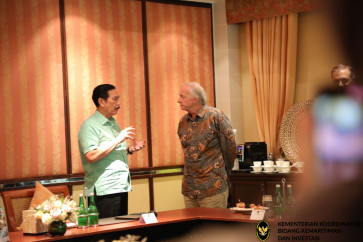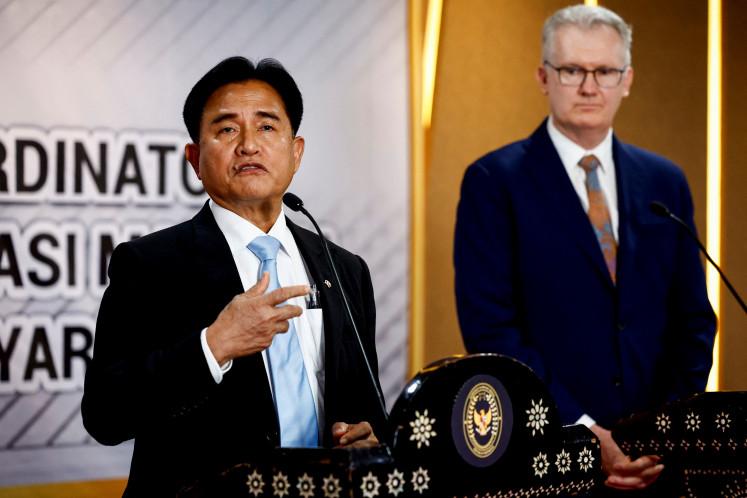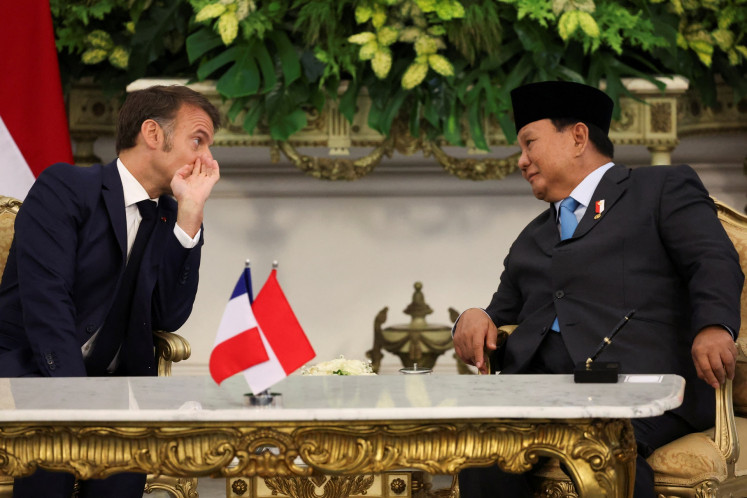Korean cool more than just K-Pop and gadgets
Koreaâs claims to fame are not limited to its popular culture and technological exports, but also includes centuries-old cultural heritage
Change text size
Gift Premium Articles
to Anyone

K
orea's claims to fame are not limited to its popular culture and technological exports, but also includes centuries-old cultural heritage.
The young woman sat glued to a chair in her room, a scattering of DVDs lying around her that bear such titles as Iljimae, Sassy Girl Chun Hyang, Secret Garden, The Greatest Love, The King 2 Heart and Bad Guy.
This time, Ina (not her real name) was engrossed in viewing the historical romance The Moon that Embraces the Sun. Another day, another drama: the 19-year-old becomes so caught up in her daily diet of Korean programs that her mom often has to remind her of dinner time.
Of course, Ina is not the only young Indonesian swept up in the wave of Korea's modern cultural imports. Many others are also hopelessly devoted to K-Pop, the musical genre whose boy and girl bands have spawned a melodic invasion of Indonesia and the world.
They have also been accompanied by the embracing of other pop culture attributes, including big screen Korean movies, fashion, hairstyles and, increasingly, the enjoyment of the nation's rich culinary tradition.
But 'the land of the morning calm' has much more to offer than its popular culture; its technological exports have also earned deserved recognition for quality, especially from Samsung.
Particularly noteworthy is that Korea has promoted the shock of the new while displaying its commitment to preserving its cultural legacies ' attesting to the yin-and-yang balancing of contrasting elements.
When it comes to music and dance, Korea also has uniqueness. According to the Korean Cultural Center, music and dance were means of religious worship and this tradition continued through the Three Kingdoms period, when the kingdoms of Silla, Baekje and Goguryeo were united as one.
No less than 30 musical instruments were used during the Three Kingdoms period, including the famed hyeonhakgeum (black crane zither), which Wang San-ak of Goguryeo created by altering the seven-string zither of Jin Dynasty China.
Also notable was the gayageum, a zither used in Gaya (A.D. 42-562). The 12-string instrument is still played in modern Korea.
Goguryeo followed the musical tradition of Silla in its early years, but came to have more diversified genres later. There were three types of music in ' Dangak, meaning music from Tang Dynasty China, Hyangak or village music, and Aak or court music. Some of the music is still used in ceremonies today, especially those involving ancestral worship.
As in music, the later Goryeo kingdom enjoyed the dance tradition of the Three Kingdoms initially, but later added more varieties with the introduction of court and religious dance from China's Song Dynasty, the website said.
Playing on
During the Joseon Dynasty, music was respected as an important element of rituals and ceremonies. Early in the dynasty, two offices dealing with musical matters were established and efforts were made to arrange musical texts.
'As a result, a canon of music called 'Akhakgwebeom' was produced in 1493. Music to be played at court is classified into three categories ' ceremonial music, Chinese music and native songs,' it said.
During King Sejong's reign, scores of new musical instruments were developed. In addition to court music, the traditions of secular music such as Dangak and Hyangak continued, the website said.
'Folk dances, including the farmers' dance, shaman dance and monk dance, became popular in the latter days of Joseon, along with the mask dance known as Sandaenori and a puppet dance,' it said.
'The mask dance combined dance with song and narrative and included shamanistic elements that greatly appealed to commoners. The performance was often accented by satirical passages that mocked the nobility to the delight of the crowds watching,' the cultural center said.
As for traditional dances, Confucian and Buddhist influences are prominent.
'Confucian influence was often repressive, while Buddhism allowed a more tolerant attitude as shown in the beautiful court dances and many shaman dances for the dead,' it said.
Painting traditions
According to the Korean Cultural Center, it is known that Korean painters showed a certain level of accumulated skills from the time of the Three Kingdoms, but most paintings have been lost because they were drawn on paper.
'As a result, it is only possible to appreciate a limited number of paintings from this age such as the tomb murals,' the center notes.
'In addition to Goguryeo mural paintings, the landscape tiles of Baekje and the Painting of the Flying Horse of Silla combine to attest to the characteristics and quality of paintings during the Three Kingdoms. These works display energetic and bold lines and well-organized composition, distinctive features of this age.'
It said that only a handful of paintings of Unified Silla remain.
'Still, the painted illustrations of the teachings of the Avatamsaka Sutra (the Flower Garland Sutra) bears witness to the refinement of the paintings of this age. Exquisite and lively lines characterize these illustrations.
Both decorative and Buddhist paintings reached a peak during the Goryeo Dynasty, when a great variety of paintings were produced. The works from this period that have survived are mainly Buddhist paintings of the 13th and 14th centuries. The main features of these works include elegant postures, delicate and exquisite folds in the clothing and refined hues, indicative of the thriving Buddhism of this epoch.
The greatest advancement in Korean painting took place during the Joseon Dynasty.
'Trained professional painters and literati artists played a leading role in the development of painting,' the center said.
'In particular, economic growth, political stability and ideological development in the 18th century served as catalysts for the predominance of uniquely Korean painting styles. This trend can be seen in landscape paintings of actual Korean scenes and genre paintings with secular themes.' (JP)









